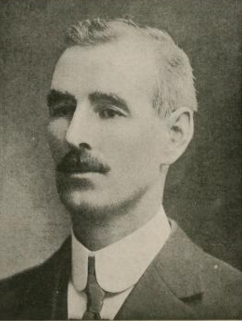
The University of Prince Edward Island (UPEI) is a public university in Charlottetown, Prince Edward Island, Canada, and the only university in the province. Founded in 1969, the enabling legislation is the University Act, R.S.P.E.I 2000.

Flora MacDonald was a member of Clan Macdonald of Sleat, best known for helping Charles Edward Stuart evade government troops after the Battle of Culloden in April 1746. Her family generally backed the government during the 1745 Rising and MacDonald later claimed to have assisted Charles out of sympathy for his situation.

Events from the year 1873 in Canada.

Andrew Archibald Macdonald, served as the fourth Lieutenant Governor of Prince Edward Island from 1 August 1884 to 2 September 1889, and was one of the fathers of Canadian Confederation.

Lord of the Isles or King of the Isles (Scottish Gaelic: Triath nan Eilean or Rìgh Innse Gall) is a title of Scottish nobility with historical roots that go back beyond the Kingdom of Scotland. It began with Somerled in the 12th century and thereafter the title was held by a series of his descendants, the Norse-Gaelic rulers of the Isle of Man and Argyll and the islands of Scotland in the Middle Ages. They wielded sea-power with fleets of galleys (birlinns). Although they were, at times, nominal vassals of the kings of Norway, Ireland, or Scotland, the island chiefs remained functionally independent for many centuries. Their territory included much of Argyll, the Isles of Arran, Bute, Islay, the Isle of Man, Hebrides, Knoydart, Ardnamurchan, and the Kintyre peninsula. At their height they were the greatest landowners and most powerful lords after the kings of England and Scotland.

Morar is a small village on the west coast of Scotland, 3 miles (5 km) south of Mallaig. The name Morar is also applied to the northern part of the peninsula containing the village, though North Morar is more usual. The coastline of the area forms part of the Morar, Moidart and Ardnamurchan National Scenic Area, one of 40 such areas in Scotland, which are defined so as to identify areas of exceptional scenery and to ensure its protection by restricting certain forms of development.
John Macdonald or MacDonald may refer to:

Lot 62 is a township in Queens County, Prince Edward Island, part of St. John's Parish. Lot 62 was awarded to Richard Spry, Esquire in the 1767 Land Lottery, and came to be settled through the efforts of Thomas Douglas, The 5th Earl of Selkirk in 1803. Richard Spry, Esquire, was then Commodore, Commander-in-Chief, Mediterranean Fleet at Gibraltar 1766–1769. Becoming the proprietor, he would be familiar with then the Island of St. John, having first come out to North America in 1754, with the English naval blockade of Ile Royal and the Fortress of Louisbourg in 1756, and then serving off Quebec and in the St. Lawrence into 1759. In 1762, he returned as Commander-in-Chief, North America, quartered in Halifax.

The Roman Catholic Diocese of Charlottetown is a diocese of the Catholic Church in Canada. It is a suffragan diocese comprising the entire province of Prince Edward Island.

Clan Macdonald of Clanranald, also known as Clan Ranald, is a Highland Scottish clan and a branch of Clan Donald, one of the largest Scottish clans. The founder of the Macdonalds of Clanranald is Reginald, 4th great-grandson of Somerled. The Macdonalds of Clanranald descend from Reginald's elder son Allan and the MacDonells of Glengarry descend from his younger son Donald. The clan chief of the MacDonalds of Clanranald is traditionally designated as The Captain of Clanranald and today both the chief and clan are recognised by the Lord Lyon King of Arms, the heraldic judge in Scotland.
Tracadie is a Canadian rural community in Queens County, Prince Edward Island. It is located southwest of Mount Stewart. The name Tracadie, which is of Mi'kmaq origin, means "ideal camping location" and is pronounced tǔlakǎdǐk.

John Alexander Macdonald, was a Canadian politician.

Sir William Christopher Macdonald was a Canadian tobacco manufacturer and major education philanthropist in Canada. Though born in Prince Edward island, he is considered a Scots-Quebecer.

Bernard Donald Macdonald was the second bishop of the Roman Catholic Diocese of Charlottetown, succeeding Bishop Bernard Angus MacEachern.

Donald Alexander MacKinnon was a Canadian teacher, lawyer, politician, author, and the eighth Lieutenant Governor of Prince Edward Island from 1904 to 1910.
John Alexander MacDonald was a farmer and political figure in Prince Edward Island. He represented 3rd Prince in the Legislative Assembly of Prince Edward Island from 1870 to 1900 as a Conservative member.
John Augustine Macdonald was a Progressive Conservative party member of the House of Commons of Canada. He was born in Cardigan, Prince Edward Island becoming a potato grower, general merchant, produce dealer by career.

John MacDonald of Glenaladale was a Scottish-born soldier, land owner and colonizer. He played an important role in bringing Scottish settlers to Prince Edward Island, Canada.

The Kensington Railway Station is a National Historic Site of Canada, located in the town of Kensington, Prince Edward Island. The train station was the third built at the site, and one of two "boulder stations" built by Charles Benjamin Chappell in 1904, so named for the fieldstone composing its exterior walls.














